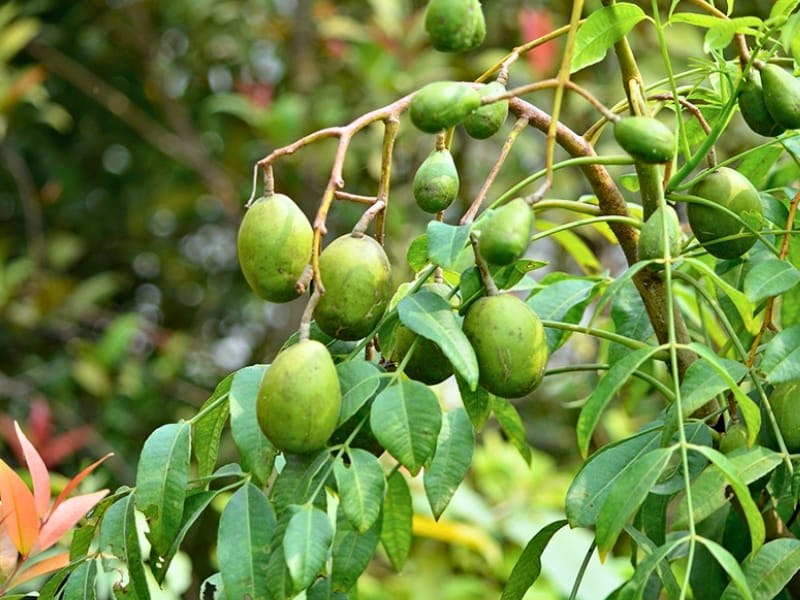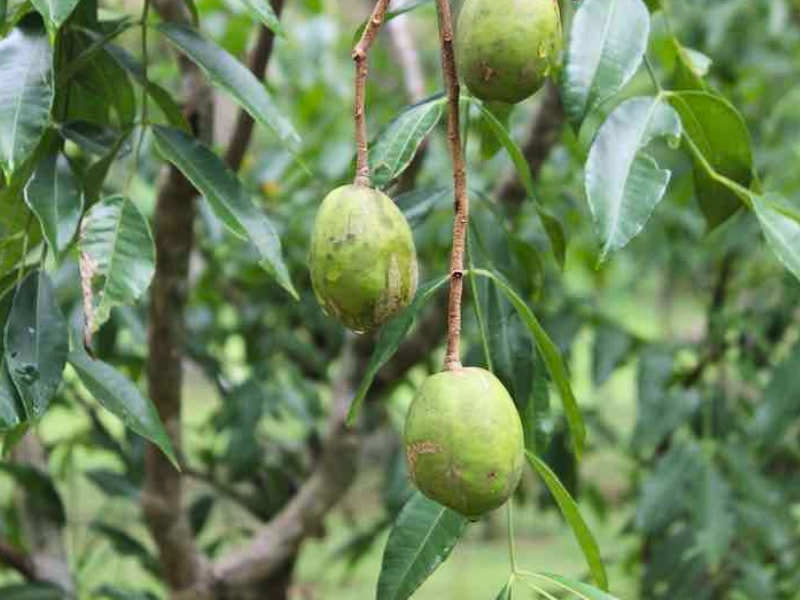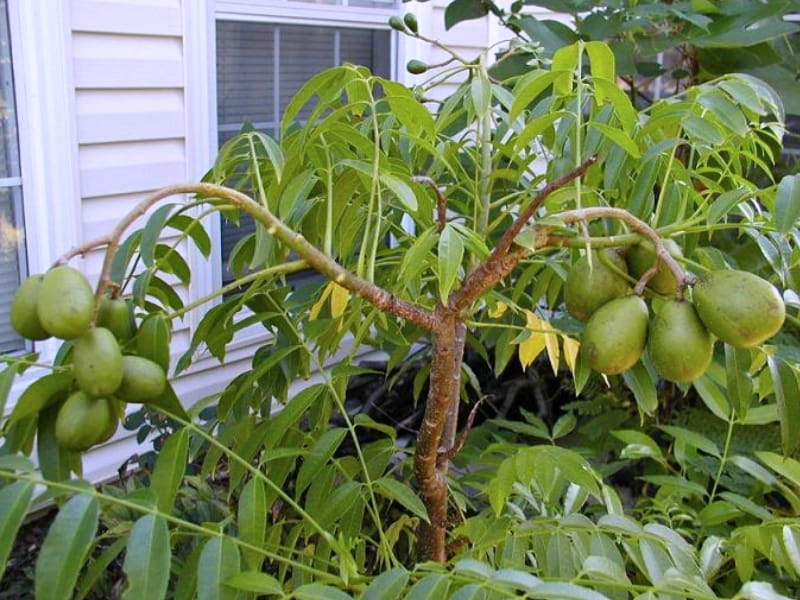The June Plum Tree, also known by its many common names like Ambarella, Golden Apple, or Jew Plum, and scientifically as Spondias dulcis, is a fast-growing, tropical fruit tree that brings a touch of the exotic to any suitable climate. This tree is renowned not just for its delicious fruit, but also its ornamental value, offering lush foliage and a relatively easy-care experience.
This guide will cover everything you need to know about this fascinating tree, from its origins and characteristics to detailed instructions on planting, caring for, and harvesting your own June Plums. We’ll even delve into some delicious recipes and explore the fruit’s surprising health benefits. Prepare to be amazed by the versatility of this tropical treasure, and keep reading to discover all of its secrets!
Let’s continue the read to get detailed instructions and learn more about June plum tree cultivation, including finding where to buy June plum trees or fruits. Discover simple June plum recipes!

Understanding the June Plum Tree: Origins, Characteristics, and Varieties
The June Plum tree, native to Southeast Asia and parts of the South Pacific, has a rich history of cultivation spanning centuries. It thrives in warm, humid climates, and has been successfully introduced to many tropical and subtropical regions around the world, including Florida, Hawaii, the Caribbean, and parts of Central and South America.
| Common name | June Plum, Ambarella, Golden Apple, Jew Plum, Kedondong, Pommecythere |
| Botanical name | Spondias dulcis |
| Family | Anacardiaceae |
| Genus | Spondias |
| Species | dulcis |
| Origin | Southeast Asia, Melanesia and Polynesia (South Pacific Islands) |
| Native | Not native to continental USA, but naturalized in Florida and Hawaii. |
| Life cycle | Perennial |
| Plant type | Tree (Tropical Fruit Tree) |
| Hardiness zone | 10, 11 (some sources indicate marginal survival in Zone 9b with protection) |
| Sunlight | Full Sun (at least 6-8 hours per day) |
| Maintenance | Moderate |
| Water | Moderate (Drought-tolerant once established, but benefits from regular watering) |
| Drainage | Well-Drained (Essential to prevent root rot) |
| Spacing | 20-30 ft. from other trees or structures |
| Flowering period | Varies by region and climate, but often spring to summer |
| Fruiting Season | Typically summer to fall, but can vary by location. |
| Height | 30-40 ft. (can reach up to 60 ft. or more in optimal conditions; dwarf varieties available) |
| Growth rate | Fast |
| Flower color | Greenish-white to yellowish-white (small, inconspicuous flowers) |
| Fruit Color | Green, transitioning to golden yellow when ripe. |
| Stem color | Grayish-brown, becoming rougher with age. |
| Flower benefit | Attracts pollinators (though not primarily grown for its flowers) |
| Fruit Benefit | Delicious, nutritious, versatile culinary uses. |
| Garden style | Tropical Garden, Edible Landscape, Orchard |
| Uses | Fruit production, Shade tree, Ornamental tree, Container (for dwarf varieties) |
| Soil pH | Slightly acidic to neutral (6.0-7.5) |
| Propagation | Seed (variability), Grafting (most reliable for desired traits), Air Layering, Cuttings. |
| Fertilizer | Balanced fertilizer formulated for fruit trees (e.g., 10-10-10 or 8-8-8 NPK) |
| Pest & Disease | Generally resistant, but can be susceptible to fruit flies, scale, mealybugs, anthracnose, and powdery mildew. |
The tree itself is a relatively fast-growing species, often reaching heights of 30 to 40 feet, though some varieties can grow even taller under optimal conditions. The canopy is typically broad and spreading, providing ample shade. The leaves are pinnate, meaning they are composed of multiple leaflets arranged along a central stem, giving the tree a feathery, tropical appearance.
One of the most distinctive features of the June Plum tree is its fruit. The fruit, technically a drupe, is oval or oblong, typically 2 to 3 inches long, and transitions from green to a golden yellow color as it ripens. The flesh is crisp and slightly acidic when green, becoming softer and sweeter as it matures. The flavor is often described as a blend of pineapple, mango, and green apple, with a hint of tartness. A single, fibrous seed is located at the center of the fruit.
Key Characteristics of the June Plum Tree:
| Feature | Description |
| Climate | Tropical, Subtropical (USDA Hardiness Zones 10-11) |
| Foliage | Pinnate, green leaves |
| Fruit | Oval/oblong drupe, 2-3 inches long, green to golden yellow |
| Flavor | Blend of pineapple, mango, green apple, with a hint of tartness |
| Seed | Single, fibrous seed |
| Fruiting Season | Varies by region, often summer to fall |

Popular June Plum Varieties:
While there aren’t as many formally named cultivars as some other fruit trees, there are variations in fruit size, flavor, and tree size within the Spondias dulcis species. Some regional variations are known by local names. Seedlings will exhibit variability, while grafted trees offer more predictable fruit quality. Generally, look for descriptions that match your preferences:
- ‘Dwarf’ Varieties: These are ideal for smaller gardens or container growing, typically reaching heights of 8-15 feet.
- ‘Golden’ Types: Often refer to varieties with a more pronounced golden-yellow color when ripe and a sweeter flavor.
- Seedling Trees: There will always be natural variations from trees grown from seeds.
A 2017 study by the University of the West Indies, St. Augustine, investigated the physicochemical properties of different June Plum varieties. They found significant variations in fruit size, acidity, and sugar content, highlighting the importance of choosing a variety that suits your taste preferences. (Source: Journal of Food Composition and Analysis, Volume 62, Pages 132-138).
Planting Your June Plum Tree: A Step-by-Step Guide
Planting a June Plum tree successfully requires careful planning and execution. Here’s a detailed, step-by-step guide to ensure your tree gets the best possible start:
Choosing the Right Location
- Sunlight: June Plum trees are sun-lovers. They need at least 6-8 hours of direct sunlight per day for optimal growth and fruit production. Choose a location that receives ample sunlight throughout the day.
- Space: Consider the mature size of the tree. While dwarf varieties are available, standard June Plum trees can grow quite large. Allow enough space for the tree to spread its branches without crowding other plants or structures. A spacing of 20-30 feet from other trees or buildings is generally recommended.
- Soil: Well-draining soil is crucial. June Plum trees do not tolerate waterlogged conditions, which can lead to root rot. Amend heavy clay soils with organic matter, such as compost or well-rotted manure, to improve drainage. A slightly acidic to neutral pH (6.0-7.5) is ideal.
- Protection from Wind: Young trees are particularly vulnerable to strong winds. If your area is prone to high winds, consider planting the tree in a sheltered location or providing a windbreak.
- Climate: The June Plum is best suited for warmer locations. Ensure you are within its hardiness range.
Preparing the Planting Hole
- Dig the Hole: Dig a hole that is twice as wide as the root ball of the tree and just as deep. This allows the roots to spread easily.
- Amend the Soil: If your soil is poor, amend the excavated soil with compost or other organic matter. This will improve drainage and provide nutrients.
- Check Drainage: Before planting, pour water into the hole to test drainage. If the water drains slowly (taking more than a few hours), you may need to further amend the soil or choose a different location.
Planting the Tree
- Carefully Remove the Tree: Gently remove the tree from its container, taking care not to damage the roots.
- Position the Tree: Place the tree in the center of the hole, ensuring that the top of the root ball is level with the surrounding ground.
- Backfill the Hole: Fill the hole with the amended soil, gently firming it around the roots to eliminate air pockets.
- Water Thoroughly: Water the tree deeply after planting to settle the soil and hydrate the roots.
- Mulch: Apply a 2-3 inch layer of organic mulch, such as wood chips or shredded bark, around the base of the tree, keeping it a few inches away from the trunk. Mulch helps retain moisture, suppress weeds, and regulate soil temperature.
Initial Watering and Care
- Watering: Water the newly planted tree regularly, especially during dry periods. The soil should be kept consistently moist, but not waterlogged.
- Fertilizing: Avoid fertilizing the tree immediately after planting. Wait a few weeks to allow the tree to establish itself. Then, use a balanced fertilizer formulated for fruit trees, following the manufacturer’s instructions.
- Staking (if necessary): If your tree is tall and slender, or if your area is windy, stake the tree to provide support. Use soft ties to avoid damaging the trunk.
Caring for Your June Plum Tree: Ongoing Maintenance
Once your June Plum tree is established, ongoing care involves regular watering, fertilizing, pruning, and pest and disease management.
Watering
- Established Trees: While June Plum trees are relatively drought-tolerant once established, they will benefit from regular watering, especially during dry spells and fruit development. Deep watering, less frequently, is better than shallow, frequent watering.
- Monitoring Soil Moisture: Check the soil moisture regularly by inserting your finger a few inches into the soil. If it feels dry, it’s time to water.
- Adjusting for Rainfall: Reduce watering during periods of heavy rainfall.
Fertilizing
- Fertilizer Type: Use a balanced fertilizer formulated for fruit trees, such as a 10-10-10 or 8-8-8 NPK ratio.
- Application Schedule: Fertilize the tree during the growing season, typically from spring to early fall. Follow the manufacturer’s instructions for application rates and frequency.
- Avoid Over-Fertilizing: Over-fertilizing can lead to excessive vegetative growth and reduced fruit production.
Pruning
- Purpose: Pruning helps maintain the tree’s shape, improve air circulation, and promote fruit production.
- Timing: Prune during the dormant season (late winter or early spring) before new growth begins.
- Techniques:
- Remove any dead, damaged, or diseased branches.
- Thin out crowded branches to improve air circulation and light penetration.
- Prune to maintain a desired shape and size.
- Remove any suckers (shoots growing from the base of the tree).
Pest and Disease Management
June Plum trees are generally resistant to pests and diseases, but they can be susceptible to certain problems, especially in humid climates.
- Common Pests:
- Fruit Flies: These can infest the fruit, causing it to rot. Use traps or appropriate insecticides if fruit flies are a problem.
- Scale Insects: These small, sap-sucking insects can weaken the tree. Treat with horticultural oil or insecticidal soap.
- Mealybugs: These cottony-looking insects can also infest the tree. Treat with insecticidal soap or neem oil.
- Common Diseases:
- Anthracnose: This fungal disease can cause leaf spots and fruit rot. Improve air circulation and use fungicides if necessary.
- Powdery Mildew: This fungal disease appears as a white, powdery coating on leaves. Improve air circulation and use fungicides if necessary.
- Prevention:
- Maintain good air circulation by pruning regularly.
- Water the tree at the base, avoiding wetting the foliage.
- Keep the area around the tree clean and free of debris.
- Monitor the tree regularly for signs of pests or diseases.

Harvesting and Enjoying Your June Plums
The moment you’ve been waiting for: harvesting your delicious June Plums!
Determining Ripeness
- Color Change: The most obvious sign of ripeness is the color change from green to golden yellow. However, some varieties may remain slightly green even when ripe.
- Softness: Gently squeeze the fruit. Ripe June Plums will yield slightly to pressure.
- Aroma: Ripe fruit often has a sweet, fragrant aroma.
- Taste Test: The ultimate test is to taste one! If it’s sweet and flavorful, it’s ready to harvest.
Harvesting Techniques
- Gentle Handling: June Plums bruise easily, so handle them with care.
- Picking: Gently twist or pull the fruit from the stem.
- Using a Pole Pruner: For fruits that are out of reach, use a pole pruner with a basket to catch the fruit.
Storage
- Room Temperature: Unripe June Plums can be stored at room temperature to continue ripening.
- Refrigeration: Ripe June Plums can be stored in the refrigerator for up to a week.
- Freezing: June Plums can be frozen for longer storage. Wash, pit, and slice the fruit before freezing.
Culinary Uses
June Plums are incredibly versatile in the kitchen.
- Fresh Eating: Enjoy them fresh, on their own, or added to fruit salads.
- Juices and Smoothies: Blend them into refreshing juices and smoothies.
- Jams and Jellies: Make delicious jams, jellies, and preserves.
- Chutneys and Sauces: Use them to create flavorful chutneys and sauces.
- Pickles: Green June Plums are often pickled.
- Desserts: Incorporate them into pies, tarts, and other desserts.
- Dried: June Plums can be dehydrated for a chewy snack.
Recipe Idea: Simple June Plum Juice
- Ingredients: 4 ripe June Plums, 1 cup water, sugar or honey to taste (optional)
- Instructions:
- Wash and pit the June Plums.
- Blend the fruit with water until smooth.
- Strain the juice through a fine-mesh sieve or cheesecloth.
- Sweeten to taste with sugar or honey (optional).
- Serve chilled.
The Health Benefits of June Plum Fruit
Beyond their delicious flavor, June Plums offer a range of nutritional benefits.
- Rich in Vitamin C: June Plums are an excellent source of Vitamin C, an antioxidant that supports the immune system and promotes healthy skin.
- Good Source of Fiber: They contain dietary fiber, which aids digestion and helps regulate blood sugar levels.
- Source of Antioxidants: June Plums contain various antioxidants that help protect the body against cell damage.
- Contains Minerals: They provide essential minerals like potassium, which is important for maintaining healthy blood pressure.
- Low in Calories: June Plums are relatively low in calories, making them a healthy snack option.
A study published in the Journal of Agricultural and Food Chemistry (2011, 59(16), pp 8879-8886) analyzed the antioxidant activity of various tropical fruits, including June Plum. The study found that June Plum exhibited significant antioxidant activity, comparable to other well-known antioxidant-rich fruits.
Frequently Asked Questions (FAQs)
- Q: How long does it take for a June Plum tree to bear fruit?
- A: Seedling trees typically take 5-7 years to bear fruit, while grafted trees may fruit in 3-4 years.
- Q: Can I grow a June Plum tree in a container?
- A: Yes, dwarf varieties of June Plum trees can be grown in large containers. Choose a container that is at least 20 gallons in size and has good drainage.
- Q: Are June Plum trees self-pollinating?
- A: June Plum trees are generally considered self-pollinating, meaning they can produce fruit with just one tree. However, planting multiple trees may improve fruit set.
- Q: What is the best time to plant a June Plum tree?
- A: The best time to plant a June Plum tree is during the spring or early summer, after the risk of frost has passed.
- Q: How do I propagate a June Plum Tree?
- A: June Plum tree can be propagated in several ways. From seeds (though will not be true to the parent), by grafting, air layering, or cuttings.
- Q: Where to buy June Plum Tree?
- A: Check the retailers recommended by Gardencenterpoint.com to buy June Plum tree that is suitable for your location. [Affiliate link placeholder to a retailer aggregator on Gardencenterpoint.com]
- Q: How much does a June Plum Tree cost?
- A: It depends on the size, location, and retailers. Usually from $30-$100.

Leave a Reply